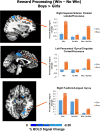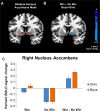Adolescent neural response to reward is related to participant sex and task motivation
- PMID: 27816780
- PMCID: PMC5698908
- DOI: 10.1016/j.bandc.2016.10.003
Adolescent neural response to reward is related to participant sex and task motivation
Abstract
Risky decision making is prominent during adolescence, perhaps contributed to by heightened sensation seeking and ongoing maturation of reward and dopamine systems in the brain, which are, in part, modulated by sex hormones. In this study, we examined sex differences in the neural substrates of reward sensitivity during a risky decision-making task and hypothesized that compared with girls, boys would show heightened brain activation in reward-relevant regions, particularly the nucleus accumbens, during reward receipt. Further, we hypothesized that testosterone and estradiol levels would mediate this sex difference. Moreover, we predicted boys would make more risky choices on the task. While boys showed increased nucleus accumbens blood oxygen level-dependent (BOLD) response relative to girls, sex hormones did not mediate this effect. As predicted, boys made a higher percentage of risky decisions during the task. Interestingly, boys also self-reported more motivation to perform well and earn money on the task, while girls self-reported higher state anxiety prior to the scan session. Motivation to earn money partially mediated the effect of sex on nucleus accumbens activity during reward. Previous research shows that increased motivation and salience of reinforcers is linked with more robust striatal BOLD response, therefore psychosocial factors, in addition to sex, may play an important role in reward sensitivity. Elucidating neurobiological mechanisms that support adolescent sex differences in risky decision making has important implications for understanding individual differences that lead to advantageous and adverse behaviors that affect health outcomes.
Keywords: Adolescence; Motivation; Reward; Risk taking; Sex differences; Sex hormones.
Copyright © 2016 Elsevier Inc. All rights reserved.
Figures



Similar articles
-
Risky decision-making in adolescent girls: The role of pubertal hormones and reward circuitry.Psychoneuroendocrinology. 2016 Dec;74:77-91. doi: 10.1016/j.psyneuen.2016.08.013. Epub 2016 Aug 17. Psychoneuroendocrinology. 2016. PMID: 27591399
-
The effect of social rank feedback on risk taking and associated reward processes in adolescent girls.Soc Cogn Affect Neurosci. 2017 Feb 1;12(2):240-250. doi: 10.1093/scan/nsw125. Soc Cogn Affect Neurosci. 2017. PMID: 27614768 Free PMC article.
-
Neural systems underlying reward cue processing in early adolescence: The role of puberty and pubertal hormones.Psychoneuroendocrinology. 2019 Apr;102:281-291. doi: 10.1016/j.psyneuen.2018.12.016. Epub 2018 Dec 13. Psychoneuroendocrinology. 2019. PMID: 30639923 Free PMC article.
-
[Risk-taking in adolescence: A neuroeconomics approach].Encephale. 2010 Apr;36(2):147-54. doi: 10.1016/j.encep.2009.06.004. Epub 2009 Sep 22. Encephale. 2010. PMID: 20434632 Review. French.
-
Effort-related functions of nucleus accumbens dopamine and associated forebrain circuits.Psychopharmacology (Berl). 2007 Apr;191(3):461-82. doi: 10.1007/s00213-006-0668-9. Epub 2007 Jan 16. Psychopharmacology (Berl). 2007. PMID: 17225164 Review.
Cited by
-
Baseline brain and behavioral factors distinguish adolescent substance initiators and non-initiators at follow-up.Front Psychiatry. 2022 Dec 8;13:1025259. doi: 10.3389/fpsyt.2022.1025259. eCollection 2022. Front Psychiatry. 2022. PMID: 36569626 Free PMC article.
-
Dopamine D2 -141C Ins/Del and Taq1A polymorphisms, body mass index, and prediction error brain response.Transl Psychiatry. 2018 May 23;8(1):102. doi: 10.1038/s41398-018-0147-1. Transl Psychiatry. 2018. PMID: 29795192 Free PMC article.
-
Testosterone, Cortisol and Financial Risk-Taking.Front Behav Neurosci. 2018 May 16;12:101. doi: 10.3389/fnbeh.2018.00101. eCollection 2018. Front Behav Neurosci. 2018. PMID: 29867399 Free PMC article. Review.
-
Sex differences in the neural underpinnings of social and monetary incentive processing during adolescence.Cogn Affect Behav Neurosci. 2018 Apr;18(2):296-312. doi: 10.3758/s13415-018-0570-z. Cogn Affect Behav Neurosci. 2018. PMID: 29442284
-
Sex differences in externalizing and internalizing traits and ventral striatal responses to monetary loss.J Psychiatr Res. 2023 Jun;162:11-20. doi: 10.1016/j.jpsychires.2023.04.013. Epub 2023 Apr 12. J Psychiatr Res. 2023. PMID: 37062201 Free PMC article.
References
-
- Bayer J, Bandurski P, Sommer T. Differential modulation of activity related to the anticipation of monetary gains and losses across the menstrual cycle. European Journal of Neuroscience. 2013;38(10):3519–3526. http://dx.doi.org/10.1111/ejn.12347. - DOI - PubMed
-
- Berridge KC, Kringelbach ML. Affective neuroscience of pleasure: Reward in humans and animals. Psychopharmacology (Berl) 2008;199(3):457–480. http://dx.doi.org/10.1007/s00213-008-1099-6. - DOI - PMC - PubMed
-
- Bjork JM, Pardini DA. Who are those “risk-taking adolescents”? Individual differences in developmental neuroimaging research. Developmental Cognitive Neuroscience. 2015;11:56–64. http://dx.doi.org/10.1016/j.dcn.2014.07.008. - DOI - PMC - PubMed
-
- Booth A, Shelley G, Mazur A, Tharp G, Kittok R. Testosterone, and winning and losing in human competition. Hormones and Behavior. 1989;23(4):556–571. Retrieved from < http://www.ncbi.nlm.nih.gov/pubmed/2606468>. - PubMed
-
- Braams BR, Peper JS, van der Heide D, Peters S, Crone EA. Nucleus accumbens response to rewards and testosterone levels are related to alcohol use in adolescents and young adults. Developmental Cognitive Neuroscience. 2016;17:83–93. http://dx.doi.org/10.1016/j.dcn.2015.12.014. - DOI - PMC - PubMed
MeSH terms
Substances
Grants and funding
LinkOut - more resources
Full Text Sources
Other Literature Sources
Medical
Research Materials

